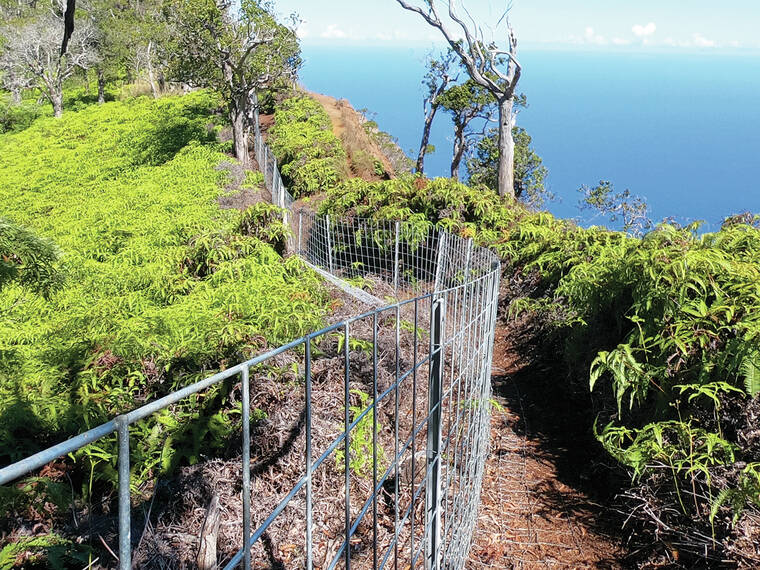HONOPU VALLEY — The Department of Land and Natural Resources has announced a special three-month hunting period in the upper Honopu Valley to clear out invasive ungulates, or nonnative hoofed animals, that cause damage to native plants and wildlife.
Following the construction of a 238-acre ungulate fence — the longest in the state and one of the country’s longest — the DLNR is now calling on Kaua‘i’s hunters to help clear out the remaining ungulates in the protected area.
“The reason we built the fence is to keep the ungulates out, and the public wants the ungulates, so we invite them in,” said Sheri Mann, Kaua‘i Island branch manager for the DLNR Division of Forestry and Wildlife. “And we usually loosen the rules and let them hunt longer and take more, generally speaking.”
Work on the fence began in September 2020 and was finally completed in early 2023, as part of a larger five-year project to protect endemic seabirds on Kaua‘i.
‘A‘o (Newell’s shearwater), ‘ua‘u (Hawaiian petrel) and ‘ake‘ake (band-rumped storm petrel) populations in the upper Honopu Valley have all been threatened by predators encroaching on their habitat.
While invasive ungulates, such as boars, deer and goats, can directly damage the birds and their nesting burrows, they also create additional harm to the ecosystem at large by trampling native plants and creating erosion through the digging of their hoofs into the landscape.
“By keeping the ungulates out, we improve the land, which saves endangered plants,” Mann said. “That, in turn, improves the habitat for more seabirds.”
However, smaller predators, such as rats, mice and cats, are still able to slip through the ungulate fencing, trampling the seabird’s burrows and killing the birds.
To prevent this, DLNR staff have installed a second, more tightly interlocked 3-acre fence within the larger fenced-off area.
Step three of the DLNR’s plan involves capturing cats, rats and barn owls that find their way into the enclosure — all of which pose significant risk to the seabird populations.
Finally, to promote the seabirds’ return to the area, the plan’s final step involves both monitoring, as well as what the DLNR calls social attraction.
“Once all the predators are out, then we go back in and put in social attraction equipment, which basically emits a sound of the birds we’re trying to bring in through speakers,” Mann said. “And then we put around decoys that look like the bird we’re trying to attract, and we’re trying to get them to come and occupy this space. There are some there already, but we’re trying to get more because it’s safe for them (here).”
Mann notes that the DLNR has made efforts to minimize the project’s impact on Kaua‘i’s hunters.
“On the scale of things, it’s quite small,” she said. “So, we’re only excluding a very small portion of the total amount of area that hunters can hunt in.”
Additionally, DLNR officials have placed several walk-through gates along the 238-acre fence to allow individuals easier passage through the area.
While the special hunting period is currently set to end after May 10, Mann notes that DLNR officials will continue to monitor the period’s impact, potentially extending it if needed.
“My staff will talk to me, and we’ll make a decision on whether it’s worth keeping it open,” she said. “So, that’s just a general timeline — we could do more if it’s warranted.”
•••
Jackson Healy, reporter, can be reached at 808-245-0427 or jhealy@thegardenisland.com.





